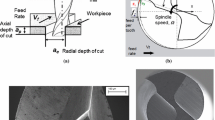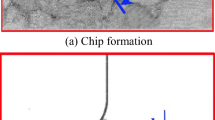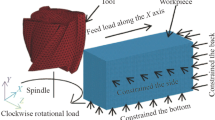Abstract
Milling is used as one of the most important tools with the complex tool geometry in industry. However, the complex milling process cannot be simulated by 2D finite element method. Therefore, a more real 3D finite element model (FEM) for the complex milling process of titanium alloy Ti6Al4V is firstly developed using the finite element software ABAQUS. This model takes into account the dynamic effects, thermomechanical coupling, material damage law, and contact criterion. Firstly, the Johnson–Cook material constitutive equation was proposed, considering the effects of strain, strain rate, and temperature on material properties. Secondly, the damage constitutive law was adopted as the chip separation criterion. Then, the simulation for the milling process of Ti6Al4V was conducted through ABAQUS based on the established 3D FEM. Finally, chip formation, stress distribution, cutting force, and milling temperature were obtained. Further, a series of milling experiments of Ti6Al4V were carried out to validate the simulation results. It confirms the capability and advantage of 3D FEM simulation in the complex milling process of titanium alloy.
Similar content being viewed by others
References
Simoneau A, Ng E, Elbestawi MA (2006) Chip formation during microscale cutting of a medium carbon steel. Int J Mach Tool Manuf 46:467–481
Jin X, Altintas Y (2012) Prediction of micro-milling forces with finite element method. J Mater Process Technol 212:542–552
Mohammadpour M, Razfar MR, Jalili Saffar R (2010) Numerical investigating the effect of machining parameters on residual stresses in orthogonal cutting. Simul Model Pract Theory 18:378–389
Molinari A, Cheriguene R, Miguelez H (2011) Numerical and analytical modeling of orthogonal cutting: the link between local variables and global contact characteristics. Int J Mech Sci 53:183–206
Shams A, Mashayekhi M (2012) Improvement of orthogonal cutting simulation with a nonlocal damage model. Int J Mech Sci 61:88–96
Deng WJ, Xia W, Tang Y (2009) Finite element simulation for burr formation near the exit of orthogonal cutting. Int J Adv Manuf Technol 43:1035–1045
Zhang Y, Mabrouki T, Neliasa D, Courbona C, Rechb J, Gong Y (2012) Cutting simulation capabilities based on crystal plasticity theory and discrete cohesive elements. J Mater Process Technol 212:936–953
Afazov SM, Ratchev SM, Segal J (2010) Modelling and simulation of micro-milling cutting forces. J Mater Process Technol 210:2154–2162
Ambati R, Pan X, Yuan H, Zhang X (2012) Modelling and simulation of micro-milling cutting forces. Comput Mater Sci 57:102–110
Zhou L, Huang ST, Wang D, Yu XL (2011) Finite element and experimental studies of the cutting process of SiCp/Al composites with PCD tools. Int J Adv Manuf Technol 52:619–626
Tang L, Huang J, Xie L (2011) Finite element modeling and simulation in dry hard orthogonal cutting AISI D2 tool steel with CBN cutting tool. Int J Adv Manuf Technol 53:1167–1181
Pantal O, Bacaria JL, Dalverny O, Rakotomalala R, Caperaa S (2004) 2D and 3D numerical models of metal cutting with damage effects. Comput Method Appl Mech 193:4383–4399
Maurel-Pantel A, Fontaine M, Thibaud S, Gelin JC (2012) 3D FEM simulations of shoulder milling operations on a 304 L stainless steel. Simul Model Pract Theory 22:13–27
Zong WJ, Li ZQ, Zhang L, Liang YC, Sun T (2013) Finite element simulation of diamond tool geometries affecting the 3D surface topography in fly cutting of KDP crystals. Int J Adv Manuf Technol 68:1927–1936
Wu H, Jia Z, Zhang X, Liu G (2012) Study on simulation and experiment of drilling for titanium alloys. Mater Sci Forum 704-705:657–663
Johnson R, Cook WK (1983) A constitutive model and data for metals subjected to large strains high strain rates and high temperatures. The 7th International Symposium on Balistics, The Hague: pp.541–547
Johnson GR, Cook WH (1985) Fracture characteristics of three metals subjected to various strains, strain rates, temperatures and pressures. Eng Fract Mech 21:31–48
Recht RF (1964) Catastrophic thermoplastic shear. Int J Appl Mech 86:189–193
Zorev NN (1963) Inter-relationship between shear processes occurring along tool face and shear plane in metal cutting. Int Res Prod Eng, ASME: 42–49
Thermal contact properties, Section 33.2.1 of ABAQUS Analysis User’s Manual, ABAQUS 6.10
Author information
Authors and Affiliations
Corresponding author
Rights and permissions
About this article
Cite this article
Wu, H.B., Zhang, S.J. 3D FEM simulation of milling process for titanium alloy Ti6Al4V. Int J Adv Manuf Technol 71, 1319–1326 (2014). https://doi.org/10.1007/s00170-013-5546-0
Received:
Accepted:
Published:
Issue Date:
DOI: https://doi.org/10.1007/s00170-013-5546-0




